Start/Stop Engine
Ignition Switch
Starting the Engine
Turning the Engine Off
Do not stop the engine while the vehicle is moving:
Stopping the engine while the vehicle is moving for any reason other than in an emergency is dangerous. Stopping the engine while the vehicle is moving will result in reduced braking ability due to the loss of power braking, which could cause an accident and serious injury.
-
Stop the vehicle completely.
-
(Manual transmission)
Shift into neutral and set the parking brake.
(Automatic transmission)
Shift the selector lever to the P position and set the parking brake.
-
Press the push button start to turn off the engine. The ignition position is off.
-
(SKYACTIV-G 2.0, SKYACTIV-G 2.5)
The cooling fan in the engine compartment could turn on for a few minutes after the ignition is switched from ON to OFF, whether or not the A/C is on or off, to cool the engine compartment quickly.
-
If the system detects that the remaining battery power of the key is low when the ignition is switched from ON to ACC or OFF, the following is indicated.
Replace with a new battery before the key becomes unusable.
Refer to Key Battery Replacement (Search).
A message is indicated in the display of the instrument cluster.
Refer to KEY Warning Indication/Warning Light (Red) (Search).
-
(Automatic transmission)
If the engine is turned off while the selector lever is in a position other than P, the ignition switches to ACC.
Emergency Engine Stop
Continuously pressing the push button start or quickly pressing it any number of times while the engine is running or the vehicle is being driven will turn the engine off immediately. The ignition switches to ACC.
i-stop
The i-stop function automatically stops the engine when the vehicle is stopped at a traffic light or stuck in traffic, and then restarts the engine automatically to resume driving. The system provides improved fuel economy, reduced exhaust gas emissions, and eliminates idling noise while the engine is stopped.
Engine idle stopping and restarting
-
After parking the vehicle, make sure that the ignition is switched OFF. There is the possibility of the vehicle moving if the vehicle is parked while i-stop is operating.
-
The i-stop indicator light (green) turns on under the following conditions:
-
When engine idling is stopped.
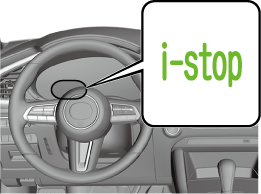
-
-
The i-stop indicator light (green) turns off when the engine is restarted.
Engine idle stopping and restarting while vehicle is stopped
(AUTOHOLD operation turned off)
-
Stop the vehicle by depressing the brake pedal and then the clutch pedal.
-
While depressing the clutch pedal, shift the shift lever to the neutral position. Engine idling stops after the clutch pedal is released.
-
The engine restarts automatically when the clutch pedal is depressed.
(When the vehicle is stopped by the AUTOHOLD function)
-
Bring the vehicle to a complete stop by depressing the brake pedal first and then the clutch pedal.
-
While depressing the clutch pedal, shift the shift lever to neutral. After releasing your foot from the clutch pedal, engine idling stops and continues to be stopped even if the brake pedal is released.
-
The engine restarts automatically when the clutch pedal is depressed.
Engine idle stopping and restarting while driving
-
The gear shift indicator (GSI) displays N when engine idling can be stopped while the change lever is in a position other than neutral.
-
Depress the clutch pedal.
-
Shift the change lever to the neutral position.
-
Engine idling is stopped after releasing the clutch pedal.
-
The engine restarts automatically when the clutch pedal is depressed.
Engine idle stopping and restarting while vehicle is stopped
(AUTOHOLD operation turned off and When not using Mazda Radar Cruise Control with Stop & Go function (MRCC with Stop & Go function)/Traffic Jam Assist (TJA))
-
Engine idling stops when the brake pedal is depressed while the vehicle is driven (except for driving in the R or M position second gear fixed mode) and the vehicle is stopped.
-
The engine restarts automatically when the brake pedal is released with the selector lever in the D or M position (not in second gear fixed mode).
-
If the selector lever is in the N or P position, the engine does not restart when the brake pedal is released. The engine restarts when the brake pedal is depressed again or the selector lever is shifted to the D, M (not in second gear fixed mode) or the R position. (For the purposes of safety, always keep the brake pedal depressed when shifting the selector lever while engine idling is stopped.)
(When the vehicle is stopped by the MRCC with Stop & Go function/TJA stop hold control)
-
When the vehicle is stopped by the MRCC with Stop & Go function/TJA, engine idling stops and continues to be stopped without depressing the brake pedal.
-
When the accelerator pedal is depressed or the RES switch is operated, while the vehicle is stopped by the MRCC with Stop & Go function/TJA, the engine will automatically restart if the selector lever is in the D/M position (not in second gear fixed mode).
(When the vehicle is stopped by the AUTOHOLD function)
-
When the brake pedal is depressed while the vehicle is being driven and the vehicle comes to a stop, the i-stop function will operate and continue to operate even if the brake is released (except when driving in the R or M position second gear fixed mode).
-
The engine restarts automatically when the accelerator pedal is depressed with the selector lever in the D/M position (not in second gear fixed mode).
-
If the selector lever is in the N or P position, the engine does not restart when the brake pedal is released. The engine restarts when the brake pedal is depressed again or the selector lever is shifted to the D, M (not in second gear fixed mode) or the R position. (For the purposes of safety, always keep the brake pedal depressed when shifting the selector lever while engine idling is stopped.)
(When using MRCC with Stop & Go function/TJA)
-
Engine idling stops when the vehicle has decelerated to about 20 km/h (12 mph) or slower while in headway control using the MRCC with Stop & Go function/TJA.
-
If it is necessary to accelerate while in headway control using the MRCC with Stop & Go function/TJA, the engine restarts automatically.
Operation conditions
Under the following conditions, engine idling stops and the i-stop indicator light (green) turns on.
-
The engine is warmed up.
-
The engine has been started and the vehicle is driven for a certain period.
-
The engine is started with the hood closed.
-
All doors, liftgate/trunk lid, and hood are closed.
-
The driver's seat belt is unfastened and the driver's door is opened.
-
The hood is opened.
-
The air conditioner is not operating with the airflow mode in the
 position.
position. -
The temperature setting dial of the air conditioner is in a position other than maximum heating or maximum cooling (A/C ON) position.
-
(Automatic climate control system)
The vehicle's interior temperature and the set temperature for the air conditioner are nearly the same.
-
The i-stop warning light (amber) is not turned on/flashing.
-
The keyless entry & push button start system functions are normal.
-
The brake vacuum is sufficiently high.
-
The battery is in good condition.
-
While vehicle is stopped
-
The selector lever is in the D or M position (not in second gear fixed mode).
-
The automatic transmission fluid has warmed up sufficiently.
-
The automatic transmission fluid temperature is not abnormally high.
-
The steering wheel is almost in the straight-ahead position (idling may not stop even with the steering wheel in the straight-ahead position if force is applied to the steering wheel. Release the force applied to the steering wheel to stop engine idling).
-
The vehicle is stopped by depressing the brake pedal.
-
The vehicle is not on a steep slope.
-
The vehicle is not stopped suddenly.
-
-
While driving
-
The selector lever is in the D or M position (not in second gear fixed mode).
-
While driving
-
The vehicle is driven at a vehicle speed of about 40 km/h (25 mph) or faster after engine idling stops while driving.
-
The vehicle is not driven in sport mode.
-
The automatic transmission fluid has warmed up sufficiently.
-
The automatic transmission fluid temperature is not abnormally high.
-
The steering wheel is almost in the straight-ahead position (idling may not stop even with the steering wheel in the straight-ahead position if force is applied to the steering wheel. Release the force applied to the steering wheel to stop engine idling).
-
The vehicle is stopped by depressing the brake pedal.
-
The vehicle is not driven on a slope.
-
The vehicle is not stopped suddenly.
-
Under the following conditions, a period of time is required to stop engine idling
-
The battery power is depleted for some reason such as the vehicle has not been driven for a long period.
-
The ambient temperature is high or low.
-
After the battery terminals are disconnected for some reason such as for battery replacement.
Engine-stop period is short or time until next engine idle stop is long
-
The ambient temperature is high or low.
-
The battery power is depleted.
-
Power consumption by the vehicle's electrical parts is high.
Engine restarts automatically while engine idling is stopped
Under the following conditions, the engine restarts automatically.
-
The i-stop OFF switch is pressed until the beep sounds.
-
The air conditioner is operated with the airflow mode in the
 position.
position. -
The temperature setting dial of the air conditioner is in the maximum heating or maximum cooling (A/C ON) position.
-
(Automatic climate control system)
The cabin temperature is largely different from the set temperature of the air conditioner.
-
The brakes are released slightly on a slope and the vehicle begins to move.
-
Two minutes have elapsed since the idling was stopped.
-
The battery power is depleted.
-
The hood is opened.
-
The driver's seat belt is unfastened and the driver's door is opened.
-
Engine idling is stopped while the vehicle is stopped
-
The accelerator pedal is depressed with the selector lever in the D or M (not in second gear fixed mode) position.
-
The selector lever is shifted to the R position.
-
The selector lever is shifted from N or P position to D or M (not in second gear fixed mode) position.
-
The steering wheel is operated with the selector lever in the D or M (not in second gear fixed mode) position.
-
The selector lever is in the M position and the second gear fixed mode is selected.
-
The steering wheel is operated.
-
-
Engine idling is stopped while driving
-
The selector lever is in a position other than the D position.
-
The accelerator pedal is depressed.
-
Sport mode is selected.
-
The steering wheel is operated.
-
The shift lever is shifted to the R position.
-
Selector lever is operated while engine idling is stopped
If the selector lever is shifted from D or M (not in second gear fixed mode) position to N or P position while engine idling is stopped, the engine does not restart even when the brake pedal is released. The engine will restart if the brake pedal is depressed again or the selector lever is shifted to the D, M (not in second gear fixed mode), or R position. (For the purposes of safety, always keep the brake pedal depressed when shifting the selector lever.)
If the selector lever is shifted from the D or M (not in second gear fixed mode) to the N or P position, and the driver's seat belt is unfastened or the driver's door is opened, the engine restarts.
Battery terminals have been disconnected
Engine idling may not stop right after the battery terminals have been disconnected. In addition, if the battery is replaced, the i-stop functions must be verified. Consult an Authorized Mazda Dealer.
i-stop OFF Switch
When pressing the switch, the i-stop function stops and the i-stop OFF switch indicator light turns on. If the switch is pressed again, the i-stop function becomes operational and the i-stop OFF switch indicator light turns off.

-
Indicator light
If the engine is stopped with the i-stop function stopped, the i-stop function becomes operational again when the engine is started the next time.
Vehicle Roll Prevention Function (Automatic transmission)
Vehicles with the i-stop function are equipped with a vehicle roll prevention function. This function prevents the vehicle from rolling, such as when releasing the brake pedal while on a slope under the following conditions:
-
While engine idling is stopped (prevents the vehicle from rolling back)
-
When the engine restarts after releasing the brake pedal (prevents the vehicle's sudden movement due to vehicle creep), sudden movement of the vehicle is prevented by controlling the brakes.
-
Release foot from brake pedal
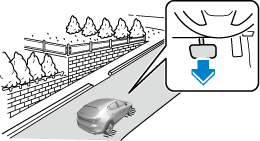
-
Vehicle brake force maintained
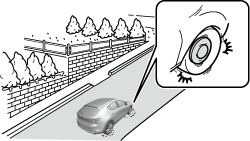
-
Engine restarted
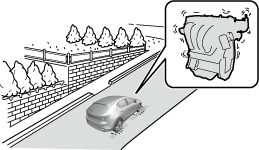
-
Acceleration
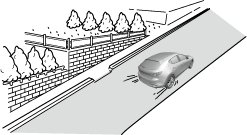
-
Do not rely completely on the vehicle roll prevention function.
-
The vehicle roll prevention function is a supplementary function which operates for a maximum of 2 seconds after releasing the brake pedal and accelerating the vehicle from an engine idling stop condition. Over reliance on the system may result in an unexpected accident if the vehicle were to suddenly accelerate. Before starting to drive the vehicle, always confirm the safety of the surroundings and operate the selector lever, brake pedal, and accelerator pedal appropriately. Note that the vehicle may move suddenly depending on the vehicle's load or if it is towing something.
-
Note that the vehicle may move suddenly after the vehicle roll prevention function is released while the vehicle is under the following conditions:
-
The selector lever is in the N position.
-
If the selector lever is shifted to the N position and the brake pedal is released while the i-stop function is operating, the brake force is gradually released. To accelerate the vehicle, release the brake pedal after the engine restarts and shift the selector lever to a position other than the N position.
-
-
When the vehicle is stopped on a steep grade, the vehicle roll prevention function does not operate because engine idling is not stopped.
-
The brake pedal response may change, sound may occur from the brakes, or the brake pedal could vibrate from the operation of the vehicle roll prevention function. However, this does not indicate a malfunction.




